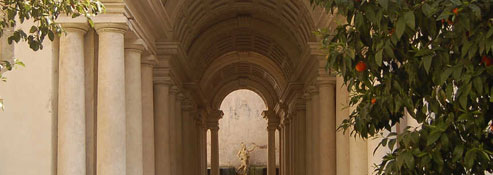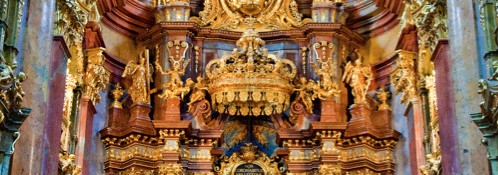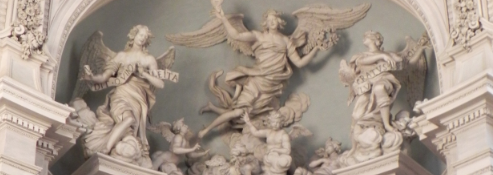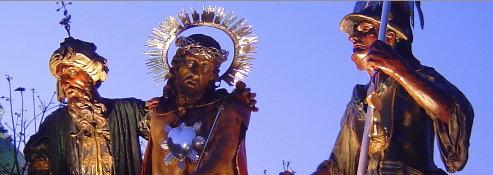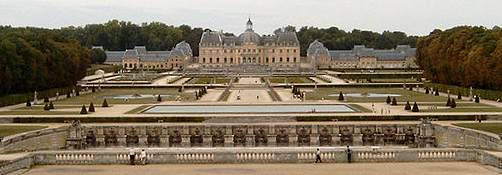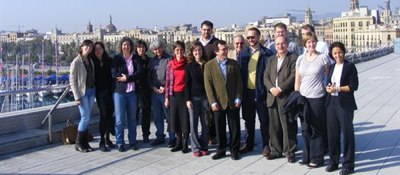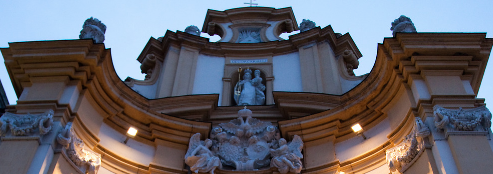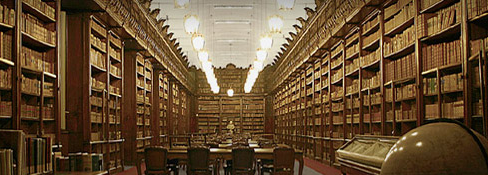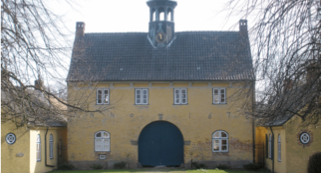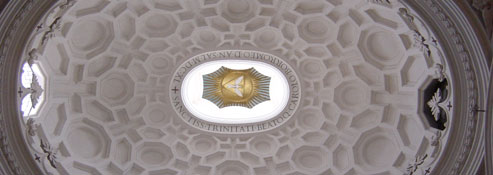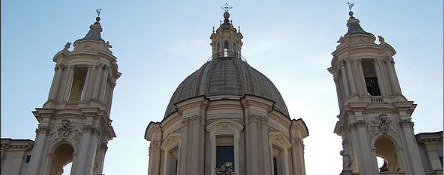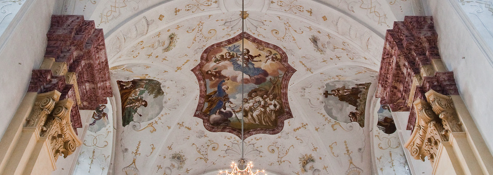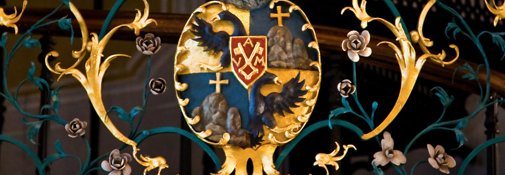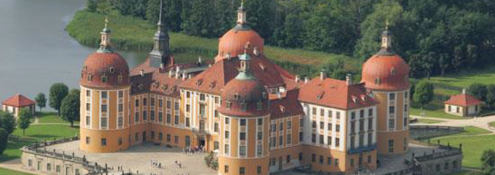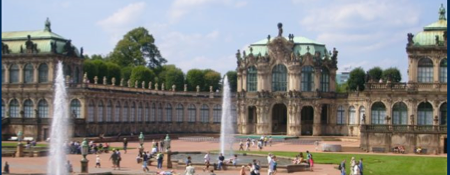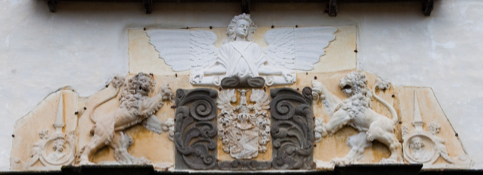Author: Piotr Wilczek
University of Warsaw
The correlation between the text and image in old manuscripts and books took a variety of forms. The most common example is emblems - compositions of an artistic and literary nature consisting of an image (frequently allegorical in theme) prefaced with a motto and accompanied by a poem (most frequently an epigram), all three components harmoniously combined to produce a meaning. Such a form of a pictographic language demonstrated a tendency present in culture since the ancient history - the tendency towards the synthesis of arts and artistic expression which would combine a verbal message with iconographic elements.
However, in both early and contemporary literature there occurs a phenomenon which appears to be the greatest manifestation of the synthesis of the word and image in one work - namely pattern (visual) poetry. It has taken many forms from antiquity to the present day and it might come as a surprise for the contemporary that compositions integrating word and image were not created in the 20th century but much earlier. You might recall such works as the calligrammes of Appolinaire, the visual poetry of Marinetti and Kolař, and concrete poetry, which transforms words into images or "concept-shapes," to use the term coined by Stanisław Dróżdż, who is the Polish most prominent concrete poet. It is quite difficult to classify concrete poetry, especially if one considers its recent manifestations, among either literature or the fine arts exclusively. The works of Ian Hamilton Finlay may exemplify the confusion in classification. [1] Both artistic fields apparently place the poetry on their margins. Historians of art and literature have never held either visual and concrete poetry in high esteem. When several years ago I developed an interest in this poetic phenomenon it turned out that the only serious Polish student of the concept was Piotr Rypson - an archeologist by profession and an expert on old and contemporary art by passion. He has recently published an extremely interesting book on early and contemporary art entitled Piramidy, słońca, labirynty. Poezja wizualna w Polsce od XVI do XVIII wieku [Pyramids, Suns, Labyrinths. Visual Poetry in Poland from the 16th to the 18th century.] [2] Apart from a dozen outstanding works by Rypson and my own contribution the phenomenon of old visual poetry is not reflected as it should be in the field of critical research. It is worth asking why. Probably it is due to the fact that border-line issues and interdisciplinary problems have always discouraged scholars who prefer to examine their own fields - be it the history of art or the even more hermetic history of literature. Yet, today interdisciplinary studies cannot be avoided, for they contribute immensely to our comprehension of works of literature and the arts; the border-line disciplines cannot be ignored either.
Since times immemorial mankind has been concerned with the problem of the writing form and shaping the letters and the concepts. The spiral on the discus of Faistos from Crete, undeciphered to date, spiral Hebrew and Aramean puns, magical texts by the Gnostics and the Egyptians, and Babylonian and biblical acrostics from the Book of Psalms, are examples which indicate that the history of visual poetry dates from ancient times. The term "visual poetry" embraces all the phenomena connected with framing poems into shapes. Kenneth Newell, an American student of this poetry, attempted to formulate the most universal definition of the visual poetry:
"A pattern poem (...) consists of one or more stanzas, each of which is printed upon the page so that its type will outline a recognizable picture to the reader's eye. The picture may be a geometric design, a silhouette of some concrete object, or even an abstract representation of some mood or idea similar to that found in the words of the stanza." [3]
This definition accounts for only one (though undoubtedly the most popular) form of visual poetry - so-called technopaegnia - poems which through the varied length of the lines represent the shapes of objects. The earliest known examples of technopaegnia date from antiquity: the three oldest visual poems, in the shape of an egg, an axe, and a pair of wings, were written by Simmias of Rhodos around 300 B.C. The poems are based on three main composition principles: iconic shape, wording and graphical representation. The three conveyors of meaning are interdependent but it is the language that plays the dominant role. [4]
The attempt to reconstruct a primeval bond between the graphical shape and the meaning of a text underlies the mechanism of the phenomenon. In the case of visual poetry there has always been a clear connection between the word and the image, the graphical shape and the meaning. Let us consider a cross-shaped poem - as it is easy to guess, in the Middle Ages this shape became the most popular kind for visual poetry. The cross of this kind is not merely an image but grows into a form of prayer and a token of meditation.
Greek technopaegnia were emulated and creatively developed during the Renaissance and Baroque. The poetry of these periods is rich not only in imitations of Greek forms (wings, altars, eggs) but also produced its own shapes. There were the poems inscribed in the framework of sacral and liturgical insignia (mitres, crosiers, rings, chalices and hosts - obviously mainly in panegyrics and encomiums glorifying church dignitaries), poems inscribed in the framework of the wings and altars, a substantial collection of architectural constructs: pyramids, obelisks, columns, archways and triumphal arches, tombs, and finally poems in the shape of coats of arms, shields, swords, flags, hearts, stars, the sun and solar clocks, flowers and wreaths, crowns, rings, astronomical equipment and towers. [5]
At this point, however, another problem arises. Very rarely did the poem itself take a certain shape; more frequently it was inscribed into a certain framework. Hence, a new kind of visual poetry flourished in modern Europe - poems in which the shape did not necessarily emerge from the text but in which the layout was dependent on typographical design; these were most frequently the poems inscribed in architectural shapes: buildings, arches or archways. They are emblems of a culture distinguished by the expansion of visual forms which were supposed to propagandize certain messages. It was not incidental that such works were most often created by authors belonging to the Society of Jesus (the Jesuits), whose main resolution was to disseminate the teaching of the Catholic Church in Protestant countries and counteract the spread of Protestantism in general. The visual glamour of Jesuit works was intended to outshine simple forms of Protestant communication and illuminate and convert the recipients.
Still another group of visual poems are Carmina quadrata (also called carmina figurata) - "They were box-like verses in which each line had the same number of letters and the number of lines in verse equaled the number of letters per line. Acrostics, telestichs, and pictorial designs were formed in the lettering by capitalizing or inking in chosen letters with a different color or by drawing in separate outlines." [6] In these poems the figure materializes through the means of versus intextii - the poems inscribed in the text or 'intratextual,' highlighted in golden, silver or scarlet hue. In modern Europe poems representing carmina quadrata were very often combined with technopaegnia poems - the first group mentioned above.
Poetic labyrinths constitute another large group of poems. Piotr Rypson defines this group as follows: "Labyrinth-poems are compositions of regular structure resembling a chess- board on whose squares the letters forming the text are arranged. According to the arrangement the reading should start either from the upper left corner or the center of such a quadrilateral labyrinth .... . Labyrinths could also assume circular or spiral shapes." [7]
The above-mentioned classification was based on a study of the most representative examples of European medieval, renaissance and baroque pattern poetry. In treatises and handbooks written at that time a category that comprises the whole variety of pattern poems cannot be found. It is obvious that the role of poetics with its rules and principles was essential in the 17th century both in Poland and across Europe. The classification proposed in the beginning of this chapter is based on the analysis of accessible material, but it is not acceptable from the historical point of view.
The old European - including Polish - poetics was theoretically based on traditional Aristotelian notions of individuum - species - genus (individual - species - genre). In practice the theory of genres and species in the 16th and 17th century Poland was far more complex. The subordination of species to genres (narrative, dramatic, and mixed) was purely theoretical. In the 17th century authors of treatises on poetics preferred to isolate a few different categories, each of them having features of all traditional genres. Usually they mentioned the folllowing genres: poesis lyrica (lyrical poetry), poesis elegiaca (elegiac poetry), poesis tragica (tragic poetry), poesis comica (comic poetry), poesis satyrica (satyric poetry), poesis epigrammatica (epigrammatic poetry), and poesis artificiosa or curiosa (artificial or curious poetry). In handbooks and treatises these genres were situated in respect to hierarchy. At first the epic poetry was the most distinguished of them but later it was replaced by so-called artificial (curious) poetry, based on baroque concepts and formal, technical tricks. [8] Definitions and examples of pattern poems can be found in treatises and handbooks within sections devoted to artificial poetry. [9]
There are no direct links between Polish theories of visual poetry and reflections that can be found in basic European works discussing this issue, i.e. in Julius Ceasar Scaliger's Poetics, George Puttenham's The Arte of English Poesie and Johann Heinrich Alsted's Encyclopedia. Puttenham, who discussed several poems written according to the rules of technopaegnion, claimed that they had an oriental origin. [10] Alsted's work is more interesting from the theoretical point of view. In his Poetica (a part of the Encyclopedia) a whole chapter is devoted to technopaegnion. One can find there definitions and pictures of poems called by him amphora poetica (poetical amphora), calix poetica (poetical chalice or cup), and ovum poeticum (poetical egg). [11] On the other hand there are several definitions of poems in Alsted's work which cannot be included in "pattern poetry", like emblems and acrostics - but it is worth mentioning that one can find them in chapters about "artificial poetry" in Polish treatises and handbooks.
Pattern poetry belongs then to the category of so-called "artificial" or "curious" poetry. Of course not all methods of shaping poetry were described in Polish treatises. Quite the reverse, this is the best case to prove the statement that the scope of the theory of literary genres and species was not strictly in line with the collection of species existing in old Polish literature. Most pattern poems belong to a large group of literary species of a non-ancient origin (like sonnet or madrigal) that cannot be found in treatises. One characteristic problem can be observed in a Polish book on poetics, Attica Musa, published in 1674 by a Piarist monk named Andrzej Krzyżkiewicz (Ignatius a S. Francisco). In a chapter entitled De ludis poeticis various examples of "artificial poetry" are discussed and there is also one pattern poem there in the shape of a pyramid (defined as an obeliscus). On the other hand in the last part of the book we can find a significant admonitio (admonition). The author warns of "new poets" who write strange "artificial" poems. Two of them - a banner and a sword - are printed in the book. They have no names, but we might call them in Latin vexillum poeticum (poetical banner) and gladium poeticum (poetical sword) according to the theory of Alsted.
There was no separate treatise on pattern poetry in Poland at that time, although it is obvious that most pattern poetry was written under the influence of the Jesuits and their cultural institutions, especially colleges, in which nearly all Polish gentry was educated at that time. The most magnificent book with pattern poems published in the 17th century Poland, Leopardus... Henrici Firley… was written by students of the Jesuit college in Kalisz as a eulogy for a new Roman Catholic archbishop. There are numerous examples of pattern poems in the rhetorical handbooks used in Jesuit colleges. Shaped poems were treated there as a part of sections of epigrammatic poetry. Writing such poetry was a part of rhetorical training in these schools. The official Jesuit educational program suggested that lecturers should teach methods of writing poetry - epigrammatic among other genres - and these methods belonged to both poetics and rhetoric. [12]
There are, however, no sources that may be helpful while studying the problem of pattern poetry in the light of the theory of genres and species. Is pattern poetry a part of "artificial poetry" or a separate genre? Is it a collection of literary species or only one species with numerous variants? It would be easy to say that there are four different species of pattern poetry, i.e. technopaegnia, carmina cancellata, labyrinths and "architectural poems" (if we of course have the right to isolate pattern poetry as a separate genre; such a notion did not exist in the period discussed) and that there are various variants of these species. But having made such a decision we face insoluble problems. This provisional classification is anachronistic, because it does not take into consideration the historical consciousness of literary genres. What is more, carmina quadrata and labyrinths often intersect and differences between them rub off. The fourth group is too heterogeneous and it is here that we can see all difficulties with any classification.
The most "legally valid" procedure will be to follow the old theories. As I mentioned above, there are not too many theoretical statements of that kind. It is worth mentioning however that in both Polish and Western European treatises on poetics there is a tendency to define separate shape poems and give them the names of objects represented by them. Examples from Alsted's Encyclopedia and the Polish handbook Attica Musa were mentioned above. This method of "creating" literary genres will make sense only with poems written in a shape of altars, wings, swords, crosses etc. In Polish books with pattern poetry we can find several poems in the shape of a banner, a star, a sword or a cross. Can they be recognized as separate literary genres? Such classification is possible but it is justified only with reference to books, especially eulogies written in Latin, which consist only of various shaped poems. There is, however, a group of poetical books written in Polish (by Adam Nieradzki and Adrian Wieszczycki) in which unique pattern poems not imitating popular structures are compact syntheses of the problems discussed in the work. Texts connecting the poetic word and the picture summarize the whole book. Typographical structure of the visual poems in Nieradzki's work is especially interesting and was compared to twentieth-century avant-garde, innovative visual prints. [13] Another example of such poetry, called sometimes "architectural," is a book by Adrian Wieszczycki entitled Archetyp albo Perspektywa żałosnego rozwodu. Poems are inserted there in the figures of a tomb monument and a magnificent obelisk. It would be difficult to analyze them as literary works; connections with baroque architecture and funeral customs seem to be more important here. It is obvious that such poems can hardly be examined from the point of view of the seventeenth-century literary theory. On the other hand, it should be mentioned here that in some poetical works written in Polish in which the text is interspersed by pattern poems, these poems are not "avant-garde" or innovative, but slightly traditional. This is the case of Wieszczycki and many others like Wojciech Waśniowski.
What solution can be provided to overcome theoretical difficulties concerning theories of literary genres and the classification of various kinds of pattern poetry? There are at least three ways of connecting poetical words with pictures. All belong to the genre of poesis artificiosa distinguished in old treatises on poetics. The first one can be called technopaegnion according to the very old tradition. Within this genre many species can be distinguished. Some of them were mentioned in old treatises. We can assume that according to this old theory every shape is a separate species. An important piece of evidence is the history of a species called "pyramid." Pyramid is the only visual species accepted by Krzyżkiewicz and separately described in his treatise Attica Musa. The significance of the pyramid as the most popular European species of pattern poetry in the 16th and 17th centuries is obvious and much evidence was collected here. [14] According to one of the modern theories even one manifestation of a literary species means that the species exists. [15] In my opinion there is no contradiction between this statement and the essence of the old theory - pyramids and also wings, altars, stars and crosses were separate literary species.
Another literary species would be carmen quadratum or cancellatum. This species was treated in old treatises as one, separate species, although we should remember that it had many variants. The third species is the poetical labyrinth with many variants as well. [16] Finally, we must turn to poems earlier called "architectural" poems. They cannot be classified in connection with old handbooks of poetics. This type of visual poetry cannot be found in such handbooks. I would claim that such works do not belong only to literature, because - in opposition to technopaegnia, carmina quadrata and labyrinths - they radically exceed the limits of literature and cannot be discussed by the theory of literature only. "Architectural poems" are usually a part of occasional architecture (triumphal arches and gates, artificial buildings, temporary decorations) and they are beyond the old poetics and modern literary theory. Many such works contain traditional, not "shaped" verses placed in an architectural structure. In my opinion such works should be studied from an interdisciplinary point of view not simply as works of literature, but as works of art.
If "architectural" poems were excluded from the world of "pure" literature, classification of pattern poetry would not be difficult. Both old and new theories of poetry can coexist here without contradictions. What is more, separation of "architectural poems," magnificent examples of baroque imagery, may lead to the creation of a field for interdisciplinary studies of a phenomenon that is beyond literature as one of the best examples of baroque synthesis of various arts.
Early visual poetry was not born out of the void. It is by no means possible to discuss or even list all the cultural phenomena strictly related with the development of the graphical forms of poetry. Some of them were alluded to earlier in this lecture. Visual poetry was undoubtedly the embodiment of the highly popular doctrine "ut pictura poesis erit" indicating extended (both thematic and structural) analogies between poetry and painting. According to Marek Komorowski: "The theory of sixteen-century painting did not radically develop the issue of structural connection between painting and poetry though it endlessly emphasized the similarity of historians, orators, poets and painters. The comparison of Renaissance theory of poetry with painting performed at that time the role similar to the one it played in late antiquity - namely, that of a figure of speech ... although the dominant role of the fine arts in the sixteenth-century culture could accentuate the comparison. It was not until the seventeenth and the eighteenth centuries that for both poetry and painting the theory of 'ut pictura poesis erit' had grown into a territory of real parallels and advanced conceptual distinctions resulting from the comprehension of the intrinsic, and not intentionally perceived, nature of both fields." [17]
The doctrine seeking to uncover the relations between painting and poetry is only indirectly linked with the concept of visual poetry. It is much more closely correlated with an interest in hieroglyphics and ideogrammes growing at that time.
It was a famous Polish literary critic, Artur Sandauer, who rendered the significance of visual poetry most explicitly, quoting ancient poetry exclusively but reaching highly universal conclusions:
"These kinds of puns ... have much deeper significance: they are aimed at the reconstruction of a primeval bond between the shape in writing and the meaning - of not a single word, indeed, but of the whole work. It must be noted that the graphical arrangement illustrates the text which, in turn, provides the caption for the graphic arrangement. Employing the natural duality of any work of literature, which consists of both the verbal and the visual, both aspects are cross-referential, functioning alternately as the content and the form." [18]
All the above-cited views refer to visual poetry from antiquity to the eighteenth century. It goes without saying that the avant-garde artistic and literary movements of the twentieth century have remodeled the forms of the visual poetry in a totally different vein. Mallarmé, the futurists and the dadaists have stimulated a fresh perception of the word-image connection. "Since the first decade of the 20th century a marked tendency towards visualization and total vocalization of the language of words and signs has become evident." [19] The phenomena which led to the birth of concrete poetry for the subject for a separate essay. It is worth remembering, however, that it all started not ten, fifty or even a hundred years ago but more than two thousand years ago when Simmias of Rhodos composed his poems in the shape of an egg, an axe and wings. For hundreds of years the formula "as is painting so is poetry" has been loomed large in the parallels between arts and literature existent in many dimensions. The phenomenon of visual poetry has become one of the most unique as well as marginal embodiments of the phrase. I believe that this is worth remembering as an example of the quest for the strongest ties between the word and the image.



